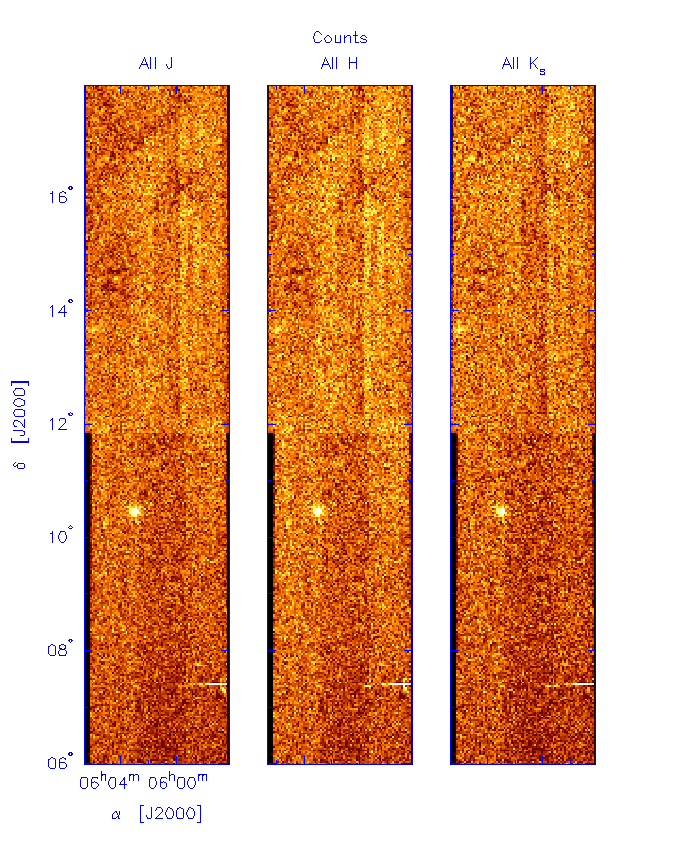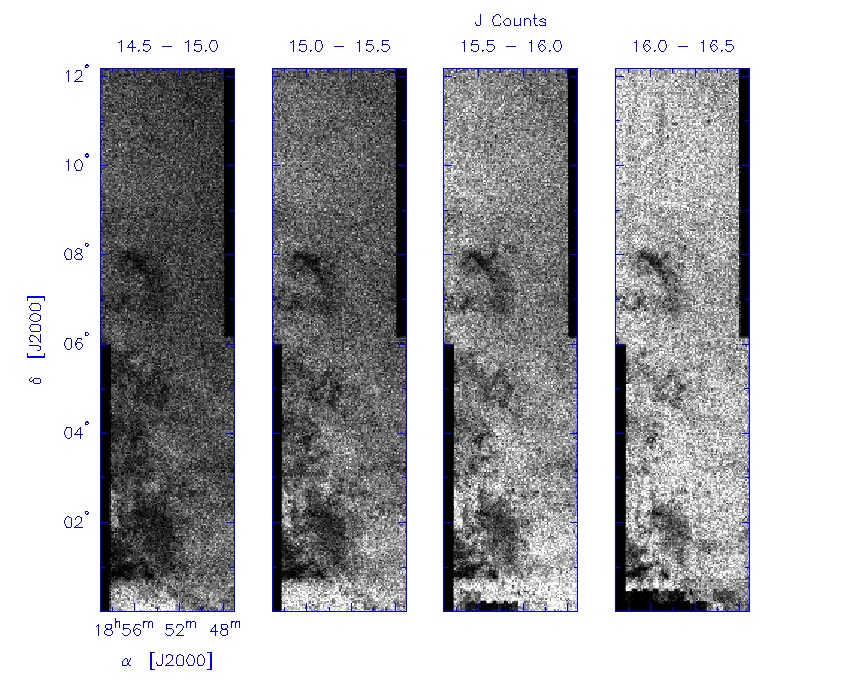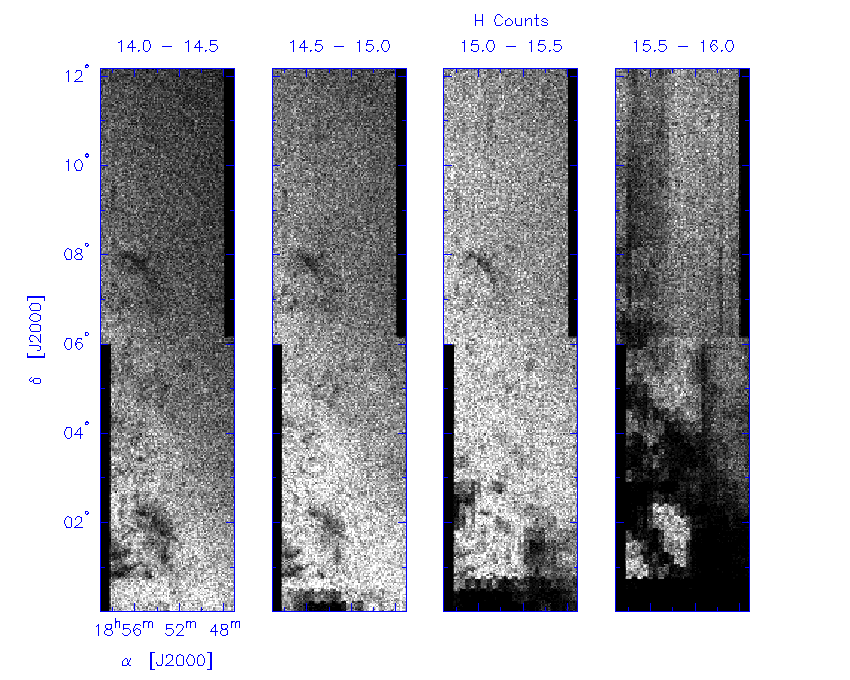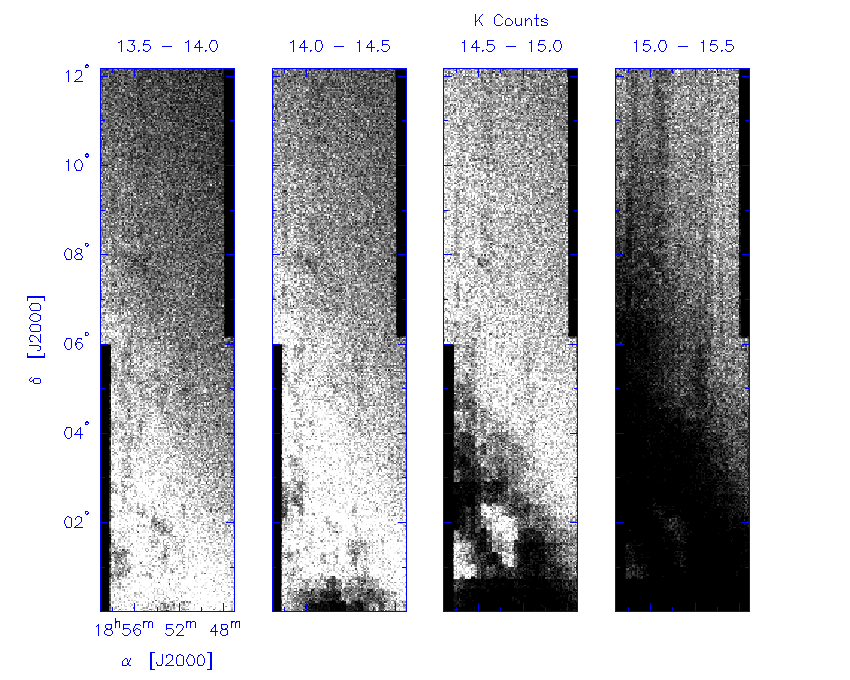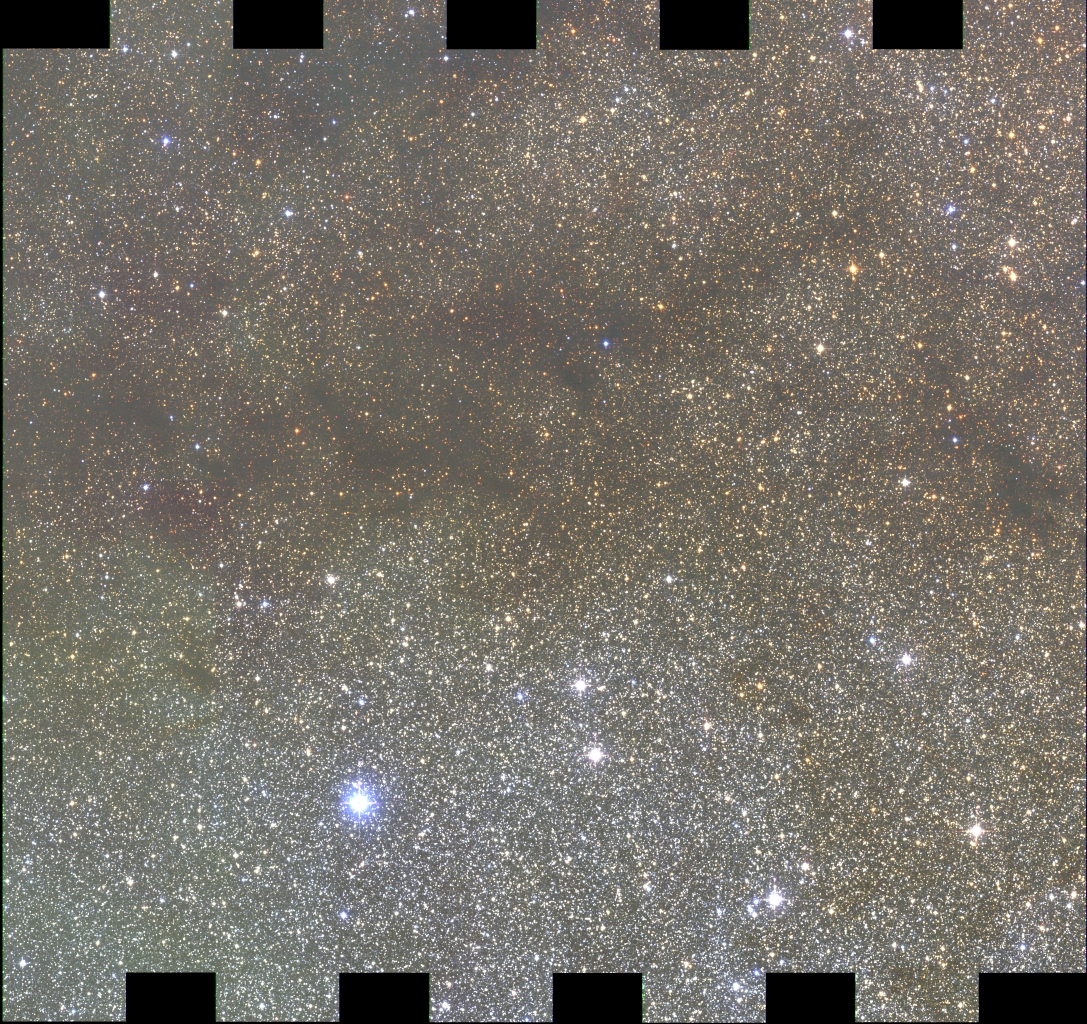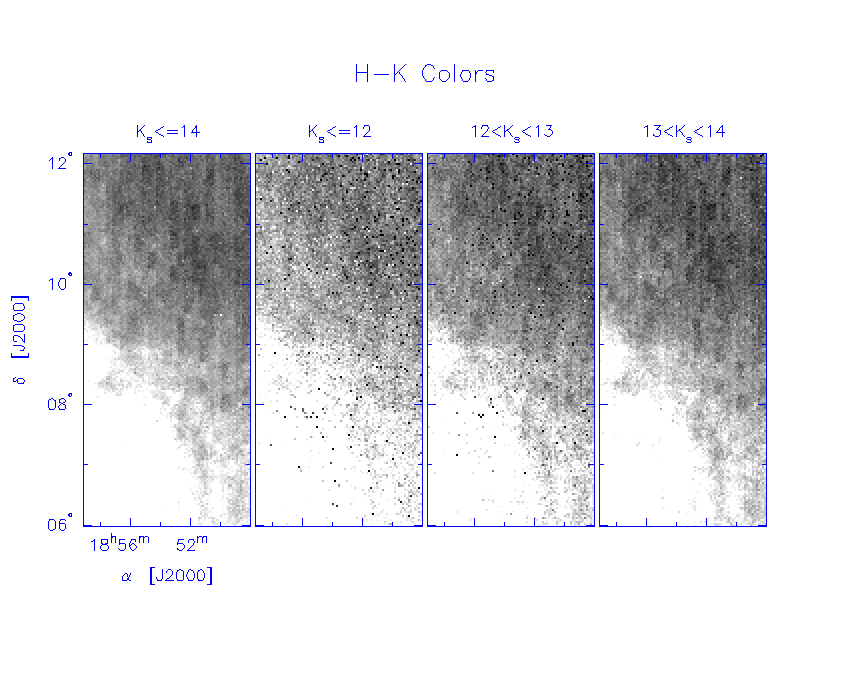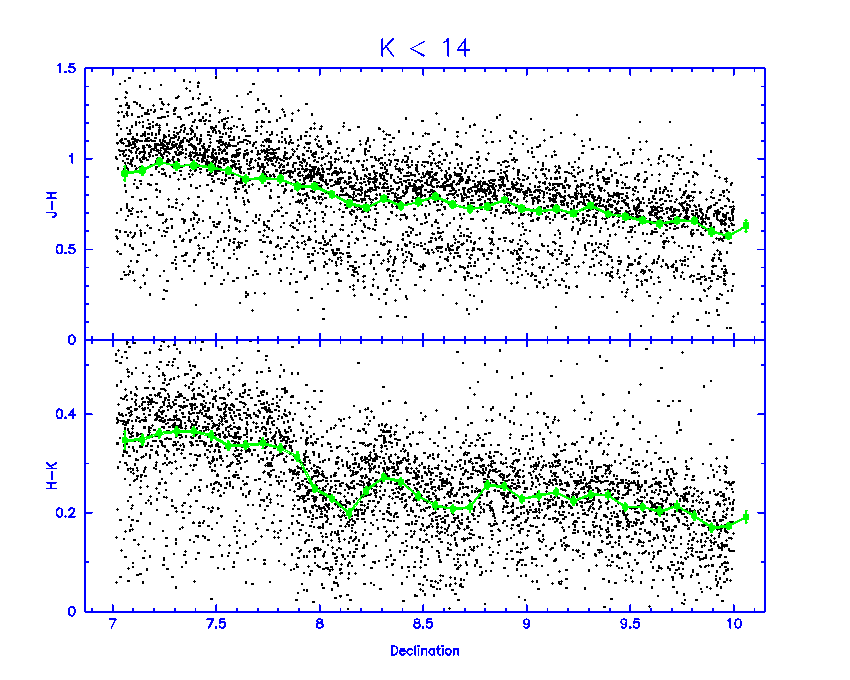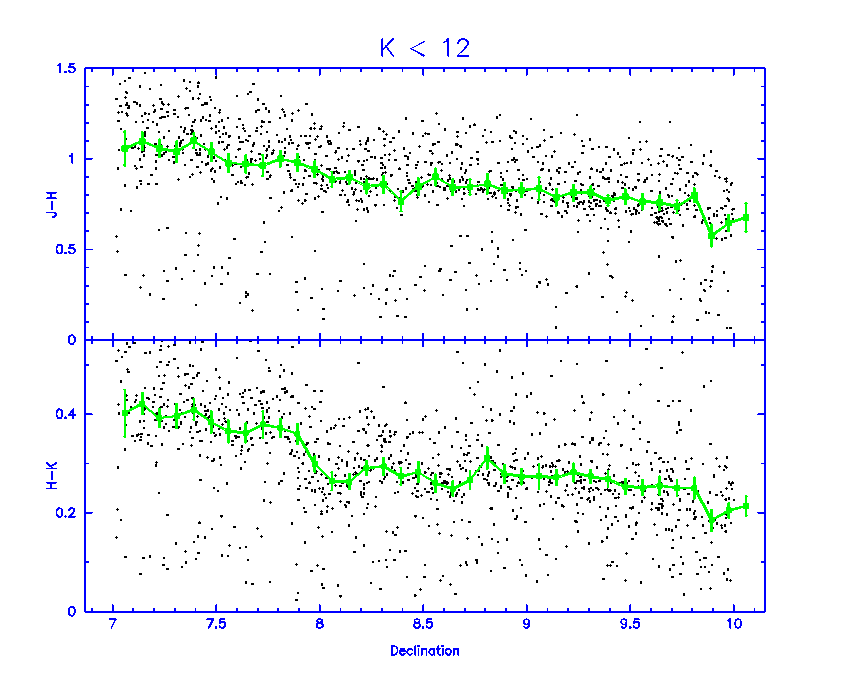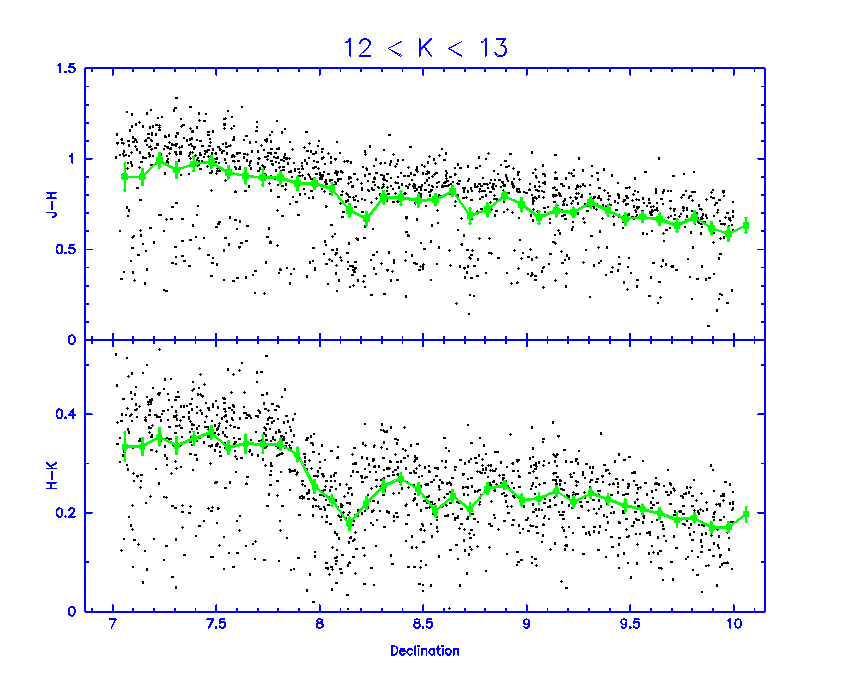Notes:
- Not surprisingly, the starcounts become incomplete toward relatively
bright magnitudes in each band. Note especially the lower left of
the starcount plot where the star counts are incomplete
at the Level 1 spec magnitudes.
- In generating the color plots, I used stars with a SNR >=7 in the
appropriate bands. Also, for J-K and H-K, I only used K <=14,
assuming that the star counts are reasonably complete for this magnitude
range.
- The "colors - zoom" plots zooms in on the top half of the image.
The tile patten can be clearly seen in the H-K image, and to a less
extent in the J-H image. It is not obvious in the J-K image, but the
large dynamic range in the J-K colors may possibly obscure the effect.
- Note also the abrupt changes in the colors in the lower left.
This looks suspicious, but I have not found found anything wrong with
the data. When I made a JHK image of the
field from the 2MASS image atlas, it does in fact show the show is
elongated in right ascension.
-
The plots labeled "colors vs. dec" show the
average H-K color vs. dec
over the region Laurent studied.
The black data points show the J-H and H-K colors vs dec for individual
stars, and the green curve shows the average colors binned in 5' intervals.
Laurent didn't label the declinations on his plot, but I assume that
the jumps in H-K color correspond to declinations of 8.1 deg and
8.6 deg in my plot.
The largest jump in H-K color is at dec=8.1. I estimated the jump in H-K
by first taking the average of the H-K color at dec=7.8 and dec=8.3
to remove the overall color gradient, and then computed the difference
between this average color and the observed color at dec=8.1.
Here are the results:
Mag range. d(H-K)
------------- ----------------
K < 14 0.103 +/- 0.009
K < 12 0.070 +/- 0.019
12 < K < 13 0.119 +/- 0.014
13 < K < 14 0.112 +/- 0.016
This confirms Laurents result that the jump in H-K color is about 0.1 mag.
Also, the jump is independent of K magnitude within the errors.
|
Notes:
- The plots are orientated in RA/Dec, but the limits (RA: 0-360 deg,
dec: 84-90 deg, with dec=90 at the center) are not labeled since the
plotting package I use cannot label the polar region correctly. In
these images, the 2MASS tiles are orientated radially.
- The bright region near the top of the plots in the star count maps
is the cluster NGC 188.
- By my eye there seems to be variations in the H-K color map corresponding
to the tiles. (These will appear as radial spokes in these polar images.)
At least on of these tiles appears to correspond to a tile that has low
overall sensitivity compared the adjacent tiles. As usual I waited until
the night before the telecon to makes these images so I cannot be more
quantitative then this.
- I noticed one region in the star count map that is an artifact. I show
a spatial plot of the stars around this artifact in the figure below,
which clearly shows the sources are due to a diffraction spike.
The offending star is Polaris! What confuses
me is that the sources are not flagged as diffraction spike artifacts.
They are flagged as "c" (lower case "c", not upper case). I take this
to mean that the 2MASS processing pipeline thinks these sources are
real. I first I thought these were artifacts where Polaris was just
off of the coadded image, and since DBMAPCOR has not been run, this test catalog
would not know that these are artifacts. This is not always the case
though. For example, here is a gif image for
the "star" located at ra,dec = (33.022235,89.262497) that is located on the same
image as Polaris.
I identified coadd image 99 on night 000914 as one example where a few
sources were not identified as diffraction-spike artifacts. The point source
listing for the objects are listed below. After looking at more images, it
is clear that the majority of the artifacts shown on my web page result when
Polaris if off the edge of the coadd and thus could not have been identified
as diffraction spikes in this processing. The following though still should
have been identified as diffraction spike artifacts.
| date|scan| ra| dec| j_m| h_m| k_m|j_msig|h_msig|k_msig|rd_flg|bl_flg|cc_flg|extd_flg|mp_flg| ndet|
000914 99 32.398064 89.261917 15.802 14.274 14.441 0.140 null null 200 100 000 0 0 260000
000914 99 32.554876 89.262260 16.059 14.910 14.058 0.186 null null 200 100 c00 0 0 160000
000914 99 33.286783 89.262939 15.945 14.255 14.607 0.178 null null 200 200 c00 0 0 560000
000914 99 33.022235 89.262497 16.202 14.413 14.679 0.190 null null 200 100 c00 0 0 060000
# Note following source is much brighter than the rest.
000914 99 37.647565 89.260933 7.837 7.782 7.673 null null 0.017 001 001 00c 0 0 000066
-
The "average color vs R.A." gif plots the average color vs. right ascension.
To decrease the contamination of the Polaris cloud to the colors, I only
included declinations between 84 and 86 deg. Still, the red colors at
ra=150-200 are from the polaris cloud.
The radial "spokes" that I was referring to can be seen as the
low H-K colors at ra=115 and ra=260. There is also a feature in the
J-H and J-K maps (but not H-K, so the problem is likely with J-band)
at ra=275. The magnitude of the offset is about 0.02-0.03 mag.
From Roc's
scan page
the offending tiles appear to be as follows:
H-K, Ra=115:
# Hemis data scan tile ra dec
n 990321 58 29610 111.359898 86.930727
n 990321 59 29611 112.518594 86.931093
n 990321 60 29612 113.679113 86.931219
n 990321 61 29613 114.842622 86.931358
n 990321 62 29614 115.987431 86.931644
n 990321 63 29615 117.152692 86.931920
H-K, RA=260:
# Hemis data scan tile ra dec
n 990418 121 29735 255.935836 86.932899
n 990418 122 29736 257.090768 86.932753
n 990418 123 29737 258.249080 86.932848
n 990418 124 29738 259.397300 86.933333
n 990418 125 29739 260.549003 86.933460
n 990418 126 29740 261.707508 86.933677
J-K, J-H, RA=275:
# Hemis data scan tile ra dec
n 991015 28 29749 271.887233 86.936659
n 991015 29 29750 273.044199 86.937270
n 991015 30 29751 274.200529 86.937499
n 991015 31 29752 275.355062 86.937490
n 991015 32 29753 276.510702 86.937508
n 991015 33 29754 277.665708 86.937347
n 991015 34 29755 278.821354 86.937396
n 991015 35 29756 279.976806 86.937533
Note that I just simply picked out the contiguous blocks at the appropriate
RA. It could be that any problems are confined to a subset of these scans.
- The plots labels "Star counts, Dup resolved" at the star count images
using the IPAC dup resolution. These were constructed to see if the dup
resolution if working correctly near the polar field, and the results
here indicate there are no problems.
| Counts: All |
Counts: Level 1 specs + 0.5 |
Counts: Level 1 specs |
|---|
 |
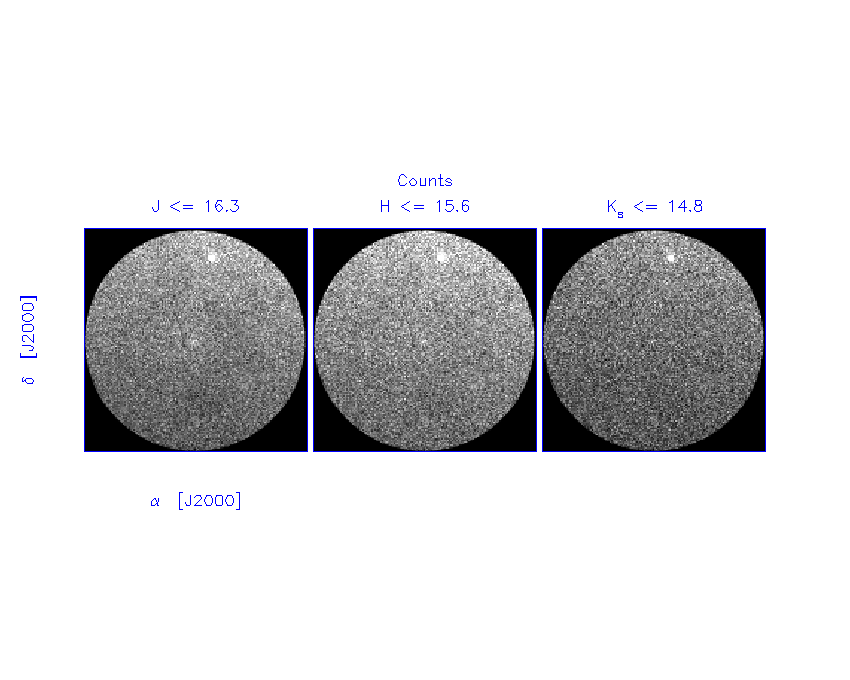 |
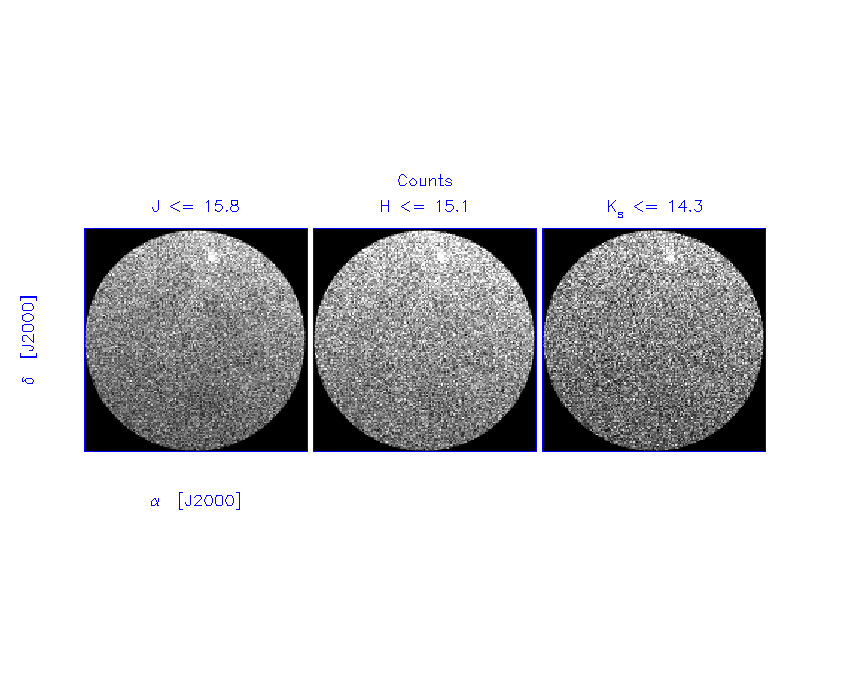 |
|
|---|
|
|---|
|
|---|
|
|---|
| Colors |
Artifact |
Average color vs. R.A. |
|---|
 |
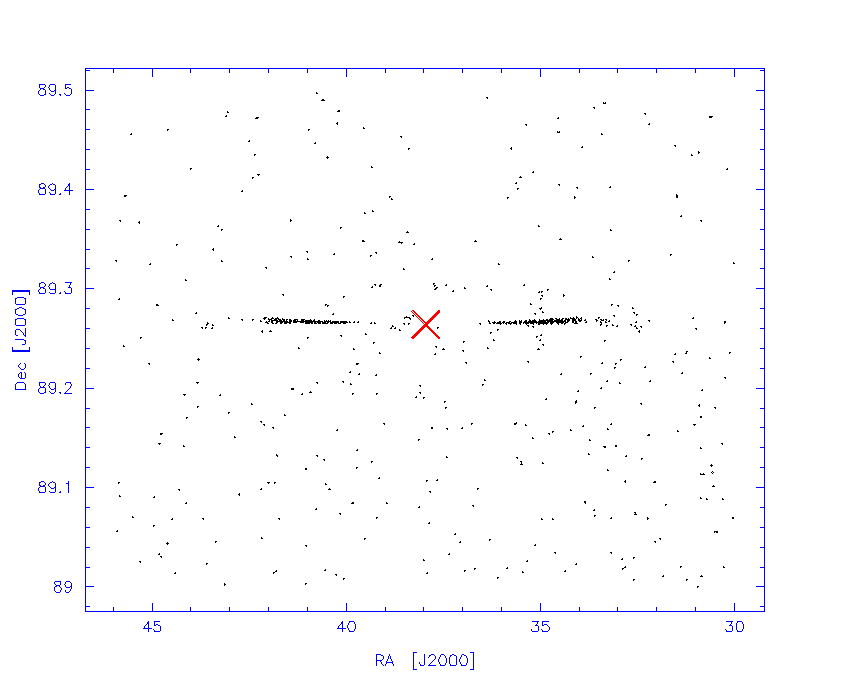 |
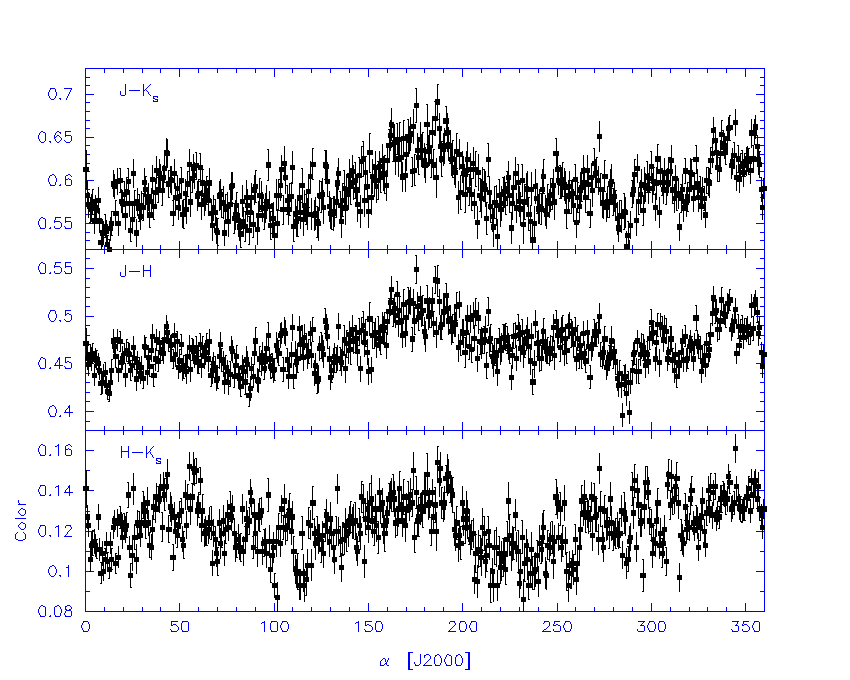 |
|
|---|
|
|---|
|
|---|
|
|---|
| Star counts, Dup resolved : J < 15.8 |
Star counts, Dup resolved : H < 15.1 |
Star counts, Dup resolved : K < 14.3 |
|---|
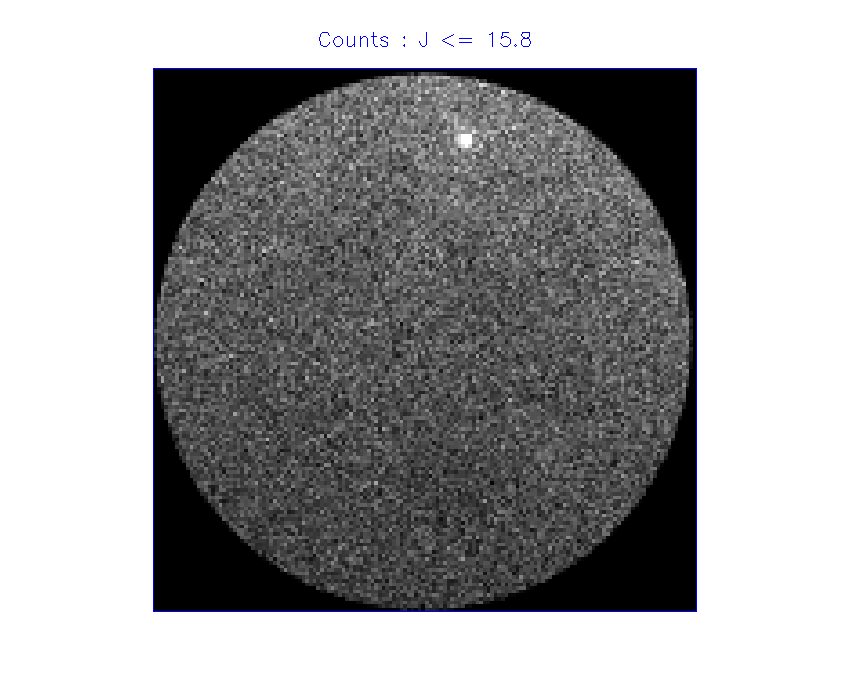 |
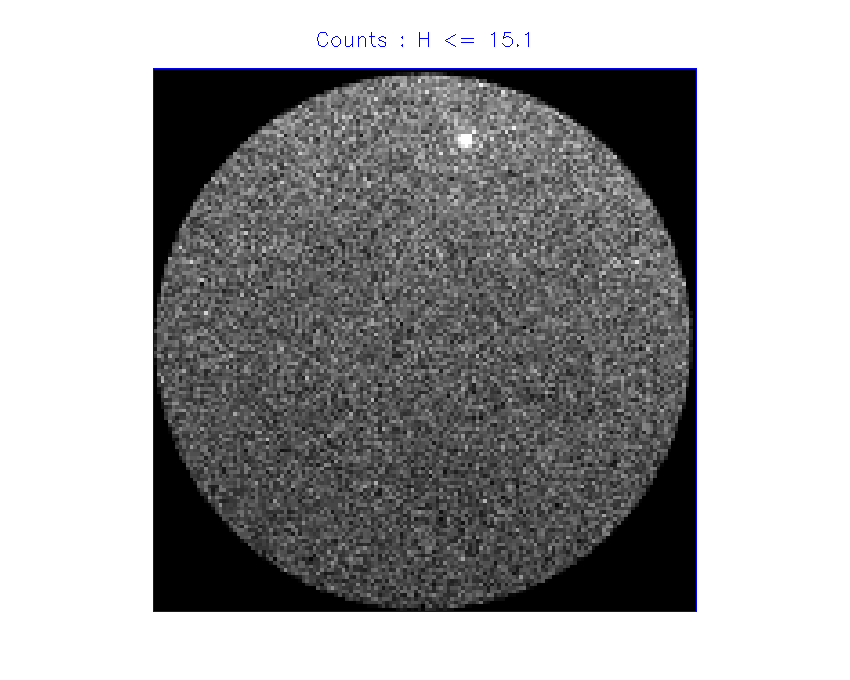 |
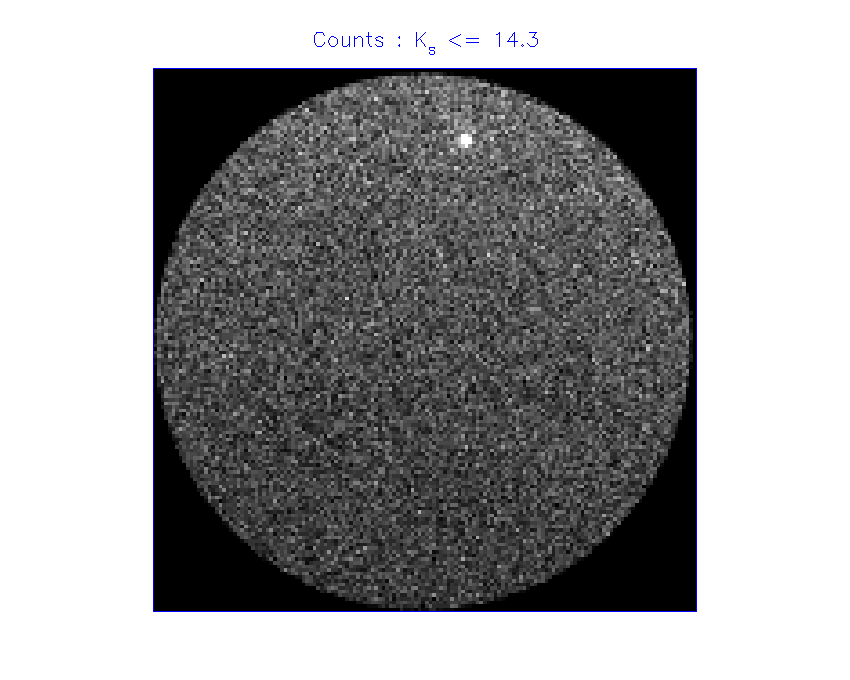 |
|
|---|
|
|---|
|
|---|
|
|---|
| Star counts, Dup resolved : All J |
Star counts, Dup resolved : All H |
Star counts, Dup resolved : All K |
|---|
 |
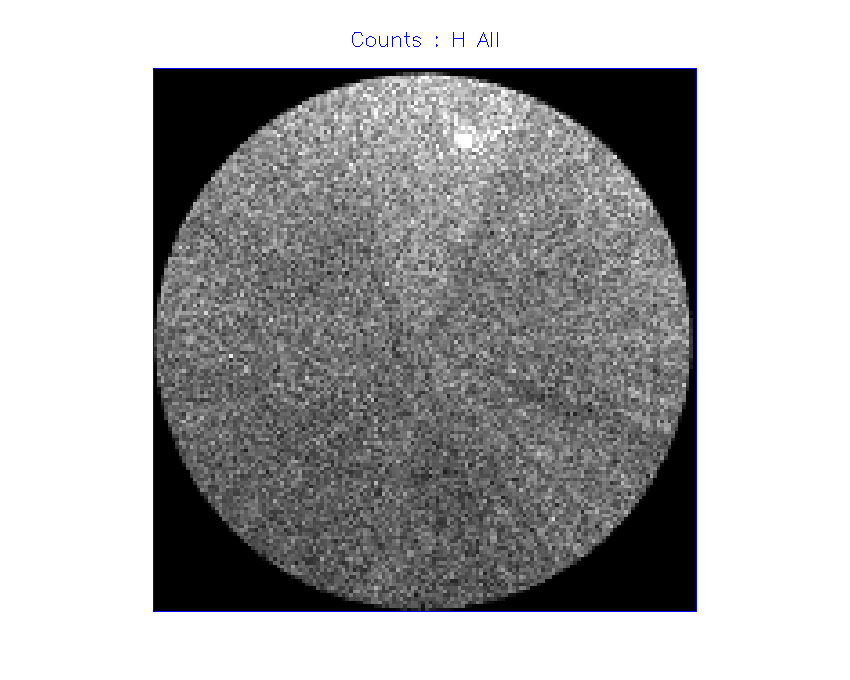 |
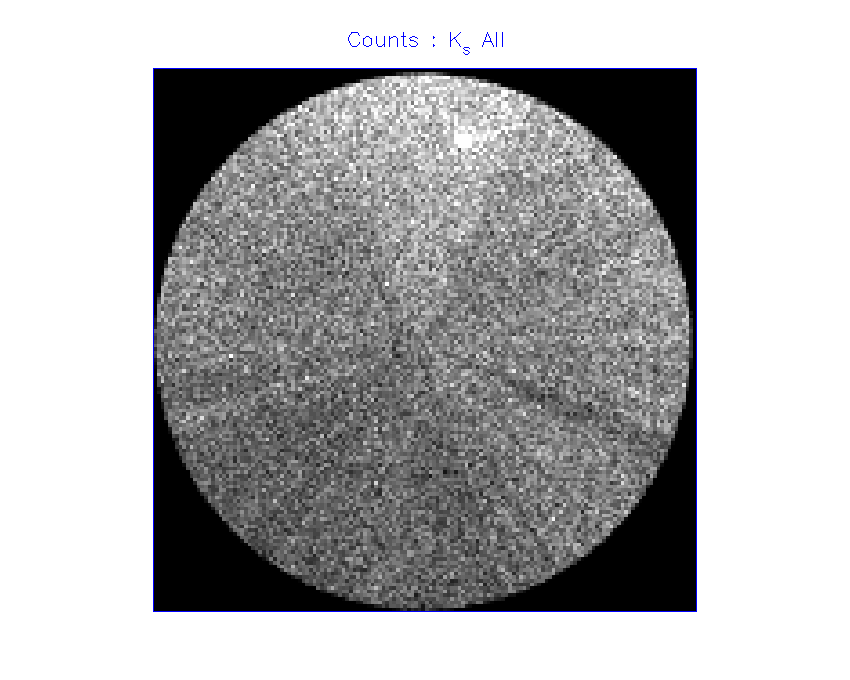 |
|
